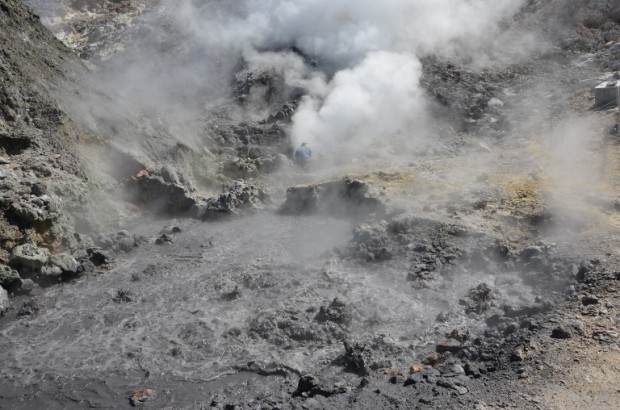
A photo taken on June 6, 2013, shows Pisciarelli fumaroles and mud pools from the Campi Flegrei caldera, a super volcano, near Naples. A slumbering volcano under the Italian city of Naples shows signs of ‘reawakening’ and may be reaching a critical pressure point, according to a study published on December 20, 2016. AFP
PARIS, France — A slumbering Campi Flegrei volcano under the Italian city of Naples shows signs of “reawakening” and may be nearing a critical pressure point, according to a study published Tuesday.
Italian and French scientists have for the first time identified a threshold beyond which rising magma under the Earth’s surface could trigger the release of fluids and gases at a 10-fold increased rate.
This would cause the injection of high-temperature steam into surrounding rocks, said lead author Giovanni Chiodini, a researcher at Italy’s National Institute of Geophysics and Volcanology in Bologna.
“Hydrothermal rocks, if heated, can ultimately lose their mechanical resistance, causing an acceleration towards critical conditions,” he told AFP by email.
It is not possible at this time to say when — or if — the volcano will erupt anew, he said.
If it did, however, “it would be very dangerous” for the half-million people living inside and near the caldera, he added, using the scientific name for the bowl-like depression created after a volcano blows its top.
Since 2005, Campi Flegrei has been undergoing what scientists call “uplift”, causing Italian authorities to raise the alert level in 2012 from green to yellow, signalling the need for active scientific monitoring.
The pace of ground deformation and low-level seismic activity has recently increased.
Two other active volcanoes — Rabaul in Papua New Guinea, and Sierra Negra in the Galapagos — “both showed acceleration in ground deformation before eruption with a pattern similar to that observed at Campi Flegrei,” Chiodini said.
The Campi Flegrei caldera was formed 39,000 years ago in a blast that threw hundreds of cubic kilometres of lava, rock and debris into the air.
It was the largest eruption in Europe in the past 200,000 years, according to scientists.
Campi Flegrei last erupted in 1538, though on a much smaller scale.
Nearby Mount Vesuvius, whose massive eruption just over 2,000 years buried several Roman settlements in the area, including Pompeii, is also classified as an active volcano.
The dense urban population at risk “highlights the urgency of obtaining a better understanding of Campi Flegrei’s behaviour,” Chiodini said.
The study was published in the scientific journal Nature Communication. CBB